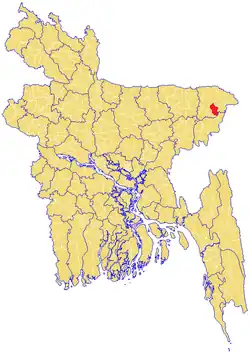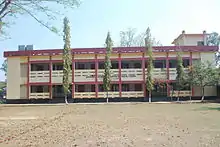Golapganj Upazila
Golapganj Upazila (Bengali: গোলাপগঞ্জ), previously known as Gulabganj, is an upazila of Sylhet District in the Division of Sylhet, Bangladesh.[1]
Golapganj
গোলাপগঞ্জ | |
|---|---|
| Golapganj Upazila | |
 | |
| Coordinates: 24.8469°N 92.0200°E | |
| Division | Sylhet Division |
| District | Sylhet District |
| Government | |
| • Mayor | Eleem Chowdhury (Awami League) |
| Area | |
| • Total | 278.34 km2 (107.47 sq mi) |
| Population (2010) | |
| • Total | 263,953 |
| Demonym(s) | Golapganji, Golapgonji, Gulabgoinji |
| Time zone | UTC+6 (BST) |
| Postal code | 3160 |
| Website | golapganj |
Geography
Golapganj Upazila (Sylhet District) area 278.34 km2, located in between 24°41' and 24°55' north latitudes and in between 91°55' and 92°06' east longitudes. It is bounded by Sylhet Sadar, Jaintiapur and Kanaighat upazilas on the north, Fenchuganj and Barlekha upazilas on the south, Beanibazar and Barlekha on the east, Sylhet Sadar and Dakshin Surma upazila on the west.[1]
History
After the Conquest of Gour in 1303, two disciple of Shah Jalal; Shah Bahauddin and Shah Putla Fattah, migrated to Bhadeshwar in modern-day Golapganj where their mazars remains today.
In 1740, during the reign of Mughal emperor Muhammad Shah, Gulab Ram Ray of Murshidabad was appointed the Dewan of Sylhet with the permission of the Faujdar of Sylhet, Shamsher Khan, and the Nawab of Bengal, Shuja-ud-Din Muhammad Khan. Gulab was a practising Hindu, and was informed about how Krishna Chaitanya's paternal home was in Dhakadakshin (in present-day Golapganj). The Dewan then ordered for a road and bridge to be made from Sylhet town to Dhakadakshin, to make it easier for those wanting to visit the place. When the Dewan reached Chaitanya's home, he built a Hindu temple and created a large pond next to it. From Hetimganj to Dhakadakshin, the road is now known as Dewan Road after Gulab himself. The Dewan's Bridge also remains today as an ancient culvert. The area was also renamed Gulabganj after the Dewan, which eventually changed to Golapganj (although older records mention the name Golabganj).
A thana was founded in Hetimganj originally and then moved to Golabganj Bazaar. The Golabganj Thana was formed in 1906. Revolts in Ronikeli and Bhadeshwar were held during the Nankar Rebellion.[2] In the aftermath of the Bangladesh Liberation War of 1971, a mass grave was found in Sundisail and there remains a monument in the upazila as a memorial.[3] It was upgraded to an upazila in 1983.[1]
Demographics
Total population of Golapganj Upzila: 263,953 male 132,189, female 131,764; Muslim 252,167, Hindu 11,725, Buddhist 21, and others 40. Indigenous communities such as Manipuri and Tripura belong to this upazila.[1] According to the census in 2011, Golapganj Upazila has a population of 316,149. Males constitute 50.29% of the population, and females 49.71%. 48.17% of the population is age eighteen or older. The average household size is 6.23 people and the population density is 1,136 person per km2. Golapganj has an average literacy rate of 57.0% (7+ years), and a national average of 32.4% literate.[3]
Main sources of income
Agriculture 34.05%, non-agricultural laborer 6.03%, industry 0.94%, commerce 14.64%, transport and communication 4.01%, service 6.16%, construction 2.88%, religious service 0.58%, rent and remittance 18.34%, and others 12.37%.[2] The main crops are paddy, chili, pumpkin, arum, and barbati.[3] Nearly extinct crops are Mustard, sesame, and linseed.[3] Main fruits are jackfruit, mango, litchi, banana, latkon, guava, lemon, shaddock, betel nut and coconut.[3]
Ownership of agricultural land
Landowner 42.76%, landless 57.24%; agricultural landowner: urban 27.98% and rural 43.91%.[2]
Administration
Golapganj Upazila is divided into Golapganj Municipality and 11 union parishads: Amura, Bagha, Bhadeshwar, Budhbaribazar, Dhaka Dakshin, Fulbari, Golapganj, Lakshanaband, Lakshmi Pasha, Sharifganj, and Uttar Badepasha. The union parishads are subdivided into 98 mauzas and 244 villages.
Golapganj Municipality is subdivided into 9 wards and 23 mahallas.[4]
List of chairmen
| Number | Name | Term |
|---|---|---|
| 01 | Fazlul Haq Tanu Mian | |
| 02 | Ghulam Muhammad Tepon | |
| 03 | Iqbal Ahmad Choudhury | 22 February 2009 – 19 September 2013 |
| 04 | Hafiz Nozmul Islam | 20 September 2013 – 31 October 2018 |
| 05 | Iqbal Ahmad Choudhury | 1 November 2018 – present |
Education

There are five colleges in the upazila: Al-Imdad College, Dhaka Dakshin Bahu Mukhi High and College, Bhadeswar College, Bhadeswar Mohila College, Dhaka Dakshin Degree College, and Kushiara College.[5]
According to Banglapedia, Bhadeshwar Nasiruddin High School, founded in 1919, Dhakadakshin Multilateral High School and College (1898), and MC Academy (1934) are notable secondary schools.[1]
Average literacy 48.24%; male 50.89%, female 45.64%.[1]
Tourist spots
Bangladesh Scouts (Sylhet region), Petrobangla, Kailash Tila and the birthplace of Sri Chaitanya Dev.'[1] Mazar of Bahauddin, house and temple of sri chaitanya Dev, Kailash Tila and Dewan Bridge.[3]
Health centres
Upazila health centre 1, union health centre 1, health and family planning centre 5, community clinic 11, maternity and child welfare centre 1, diagnostic centre 3, veterinary hospital 1.
| Climate data for Golapganj | |||||||||||||
|---|---|---|---|---|---|---|---|---|---|---|---|---|---|
| Month | Jan | Feb | Mar | Apr | May | Jun | Jul | Aug | Sep | Oct | Nov | Dec | Year |
| Average high °C (°F) | 25.1 (77.2) |
27.2 (81.0) |
30.8 (87.4) |
31.4 (88.5) |
31.1 (88.0) |
30.9 (87.6) |
31.1 (88.0) |
31.5 (88.7) |
31.4 (88.5) |
30.7 (87.3) |
28.9 (84.0) |
26.2 (79.2) |
29.7 (85.5) |
| Average low °C (°F) | 11.8 (53.2) |
13.5 (56.3) |
17.6 (63.7) |
21.0 (69.8) |
22.6 (72.7) |
24.5 (76.1) |
25.0 (77.0) |
25.1 (77.2) |
24.5 (76.1) |
22.2 (72.0) |
17.5 (63.5) |
13.3 (55.9) |
19.9 (67.8) |
| Average precipitation mm (inches) | 14 (0.6) |
31 (1.2) |
119 (4.7) |
322 (12.7) |
566 (22.3) |
752 (29.6) |
694 (27.3) |
556 (21.9) |
440 (17.3) |
231 (9.1) |
36 (1.4) |
7 (0.3) |
3,768 (148.3) |
| Source: Climate-data.org | |||||||||||||
Notable people
- Arjumand Ali, first Bengali Muslim novelist
- Ohid Ahmed, Deputy Mayor of London Borough of Tower Hamlets
- Abdul Matin Chaudhary, first Agriculture Minister of Pakistan
- Sadruddin Ahmed Chowdhury, physicist and vice-chancellor of Shahjalal University of Science and Technology and Sylhet International University
- Aminul Hoque MBE, lecturer at Goldsmiths, University of London, writer
- Syed Makbul Hossain, doctor and politician
- Sharaf Uddin Khashru, local politician
- Fatema Chowdhury Paru, politician
- Abdur Rahim, advocate, freedom fighter and politician
- AKM Gouach Uddin, Jatiya Party politician
References
- Parvez, Azizul (2012). "Golapganj Upazila". In Islam, Sirajul; Jamal, Ahmed A. (eds.). Banglapedia: National Encyclopedia of Bangladesh (Second ed.). Asiatic Society of Bangladesh.
- Bangladesh Population Census 2001, Bangladesh Bureau of Statistics; Field report of Golabganj Upazila 2010.
- "Population Census Wing, BBS". Archived from the original on 27 March 2005. Retrieved 10 November 2006.
- "District Statistics 2011: Sylhet" (PDF). Bangladesh Bureau of Statistics. Archived from the original (PDF) on 25 April 2015. Retrieved 14 July 2014.
- "List of Colleges". Department of Secondary and Higher Education. Retrieved 6 September 2020.
- "G Voice24". www.google.com. Retrieved 12 April 2022.
- "G Voice24". Website (in Bengali). Retrieved 12 April 2022.
Source Bangladesh Population Census 2001, Bangladesh Bureau of Statistics.
External links
- List Of Union Parishad - Local Government Engineering Department
- Golapganj Upazila - Banglapedia
- Official Website - Golapganj Upazila
